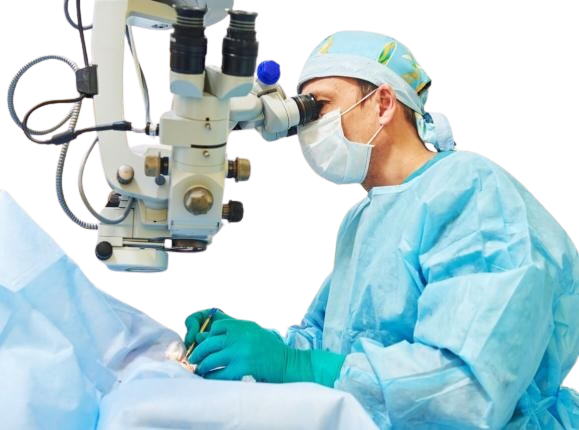Glaucoma Treatment Expert in Perumbakkam
Your Trusted Partner in Glaucoma Treatment
Glaucoma treatment aims to preserve vision by reducing intraocular pressure and preventing further damage to the optic nerve. Our healthcare providers are committed to delivering comprehensive care and guidance throughout the glaucoma treatment process, ensuring optimal outcomes and preserving vision for our patients.

Understanding Glaucoma & Glaucoma Treatment
Glaucoma is a group of eye conditions that damage the optic nerve, often due to increased pressure within the eye. It can result in vision loss and blindness if left untreated. Glaucoma is often referred to as the “silent thief of sight” because it typically progresses slowly and without symptoms until significant vision loss occurs.
Glaucoma treatment aims to lower intraocular pressure (IOP) to prevent or slow down the progression of the disease and preserve vision. Treatment options may include medications (eye drops, oral medications), laser therapy (laser trabeculoplasty, laser iridotomy), and surgical procedures (trabeculectomy, minimally invasive glaucoma surgery).
Anyone diagnosed with glaucoma or at risk of developing glaucoma should undergo treatment to prevent vision loss and preserve visual function. Risk factors for glaucoma include elevated intraocular pressure, family history of glaucoma, age over 60, African American or Hispanic ethnicity, and certain medical conditions such as diabetes and high blood pressure. Early detection and treatment are crucial to managing glaucoma effectively and preventing irreversible vision loss.
Causes of Glaucoma
Increased Intraocular Pressure (IOP): Elevated IOP occurs when there is an imbalance between the production and drainage of aqueous humor, the fluid inside the eye. If the fluid cannot drain properly, pressure builds up, leading to optic nerve damage and glaucoma.
Family History:
A family history of glaucoma increases the risk of developing the condition. Certain genetic factors may predispose individuals to glaucoma, making them more susceptible to optic nerve damage even with normal IOP levels.
Age: Glaucoma becomes more common as people age, particularly after the age of 40. The risk of developing glaucoma increases with advancing age, with older adults being at higher risk.
Medical Conditions: Certain medical conditions, such as diabetes, hypertension (high blood pressure), cardiovascular diseases, and thyroid disorders, can increase the risk of glaucoma. Additionally, a history of eye injuries or surgeries may also contribute to the development of glaucoma.
Eye Anatomy and Eye Trauma: Structural abnormalities in the eye, such as a narrow drainage angle or thinning of the optic nerve, can increase the risk of glaucoma. These anatomical variations may interfere with the normal flow of aqueous humor and lead to elevated intraocular pressure. Trauma to the eye, such as blunt force trauma or penetrating injuries, can damage the optic nerve and increase the risk of glaucoma, especially if there is disruption to the drainage system or bleeding within the eye.
Use of Corticosteroids: Long-term use of corticosteroid medications, whether in the form of eye drops, oral tablets, or injections, can increase intraocular pressure and potentially lead to glaucoma, particularly in susceptible individuals.
Treatments
Lifestyle Modifications:
- Regular Exercise: Engaging in moderate exercise can help improve blood flow to the optic nerve and lower intraocular pressure.
- Healthy Diet: Consuming a diet rich in antioxidants, vitamins, and minerals may help protect against optic nerve damage.
- Avoiding Smoking: Smoking can increase the risk of developing glaucoma and exacerbate existing symptoms. Quitting smoking can help reduce this risk.
Medications:
- Eye Drops: Prescription eye drops are often the first line of treatment for glaucoma. These medications work by either reducing the production of aqueous humor (fluid in the eye) or increasing its drainage to lower intraocular pressure.
- Oral Medications: In some cases, oral medications may be prescribed to lower intraocular pressure or manage other underlying conditions contributing to glaucoma.
Non-Surgical Treatments:
- Laser Therapy: Laser procedures such as laser trabeculoplasty and laser iridotomy are commonly used to improve the drainage of fluid from the eye, thereby reducing intraocular pressure.
- Minimally Invasive Glaucoma Surgery (MIGS): MIGS procedures involve implanting tiny devices to improve fluid drainage from the eye. These procedures are less invasive than traditional glaucoma surgeries and typically have a faster recovery time.
Surgical Intervention:
- Trabeculectomy: This traditional glaucoma surgery involves creating a small flap in the sclera (the white part of the eye) to allow fluid to drain from the eye, reducing intraocular pressure.
- Glaucoma Drainage Devices: These devices are implanted in the eye to create a new drainage pathway for fluid, bypassing the natural drainage system.
- Cyclophotocoagulation: This procedure uses laser energy to reduce the production of aqueous humor in the eye, lowering intraocular pressure.
Frequently Asked Questions on Glaucoma Treatment
Glaucoma is a group of eye conditions that damage the optic nerve, often due to increased pressure within the eye. It can lead to vision loss and blindness if left untreated.
Yes, glaucoma is treatable, but it requires lifelong management to control intraocular pressure and prevent further damage to the optic nerve. Early detection and treatment are crucial for preserving vision.
Like all medications, glaucoma eye drops may have side effects, including stinging, redness, blurred vision, and systemic side effects such as fatigue or changes in heart rate. It’s essential to discuss any concerns with your eye care professional.
The need for additional surgeries depends on various factors, including the type and severity of glaucoma, the effectiveness of previous treatments, and individual response to therapy. Your eye care professional will monitor your condition and recommend further interventions as needed.
Glaucoma eye drops are typically used once or twice daily, as prescribed by your eye care professional. It’s crucial to follow the prescribed regimen consistently to control intraocular pressure effectively.
If left untreated, glaucoma can lead to irreversible vision loss and blindness. Early detection and timely treatment are essential for preserving vision and maintaining visual function.
